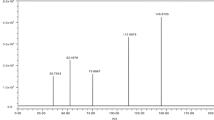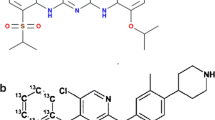Abstract
Simotinib is a novel oral small-molecule tyrosine kinase inhibitor that has demonstrated equal or superior antineoplastic activities to erlotinib in preclinical studies. In support of a clinical pharmacokinetic study, a sensitive and accurate liquid chromatography (LC) method with mass spectrometry detection using multiple reaction monitoring (MRM) in positive ion mode was developed and validated for the quantification of simotinib in human plasma. The sample preparation procedure involved a simple protein precipitation with methanol. Erlotinib was used as the internal standard. The optimal chromatographic behavior was achieved on a Zorbax SB-C8 column (2.1 mm × 100 mm, 3.5 μm) using a mixture of 0.1 % formic acid with 10 mM ammonium formate/methanol (20:80, v/v) as the mobile phase. The total LC analysis time per injection was 4 min with a flow rate of 0.2 mL/min. The recovery was greater than 90 % and no significant matrix effect was observed. The assay was validated over the concentration range of 1–1,000 ng/mL. The intra- and interday precision and accuracy of the quality control samples at low, medium, and high concentration levels showed at most 9.4 % relative standard deviation (RSD) and −7.4 to 7.4 % relative errors (RE). Assay selectivity, freeze/thaw stability, storage stability, and dilution effects were also assessed. The method is now used to support clinical pharmacokinetic studies in patients with non-small cell lung cancer (NSCLC) after oral administration of simotinib.

Simotinib, an innovative small-molecule EGFR TKI, can be quickly quantified in human plasma using UPLC-MS/MS assay



Similar content being viewed by others
References
Jemal A, Center MM, DeSantis C, Ward EM (2010) Global patterns of cancer incidence and mortality rates and trends. Cancer Epidemiol Biomarkers Prev 19:1893–1907
Ramalingam SS, Owonikoko TK, Khuri FR (2011) Lung cancer: new biological insights and recent therapeutic advances. CA Cancer J Clin 61:91–112
Breathnach OS, Freidlin B, Conley B, Green MR, Johnson DH, Gandara DR, O’Connell M, Shepherd FA, Johnson BE (2001) Twenty-two years of phase III trials for patients with advanced non-small-cell lung cancer: sobering results. J Clin Oncol 19:1734–1742
Paez JG, Janne PA, Lee JC, Tracy S, Greulich H, Gabriel S, Herman P, Kaye FJ, Lindeman N, Boggon TJ, Naoki K, Sasaki H, Fujii Y, Eck MJ, Sellers WR, Johnson BE, Meyerson M (2004) EGFR mutations in lung cancer: correlation with clinical response to gefitinib therapy. Science 304:1497–1500
Chen X, Liu Y, Roe OD, Qian Y, Guo R, Zhu L, Yin Y, Shu Y (2013) Gefitinib or erlotinib as maintenance therapy in patients with advanced stage non-small cell lung cancer: a systematic review. PLoS One 8:e59314
Juhasz E, Kim JH, Klingelschmitt G, Walzer S (2013) Effects of erlotinib first-line maintenance therapy versus placebo on the health-related quality of life of patients with metastatic non-small-cell lung cancer. Eur J Cancer 49:1205–1215
Brand TM, Iida M, Wheeler DL (2011) Molecular mechanisms of resistance to the EGFR monoclonal antibody cetuximab. Cancer Biol Ther 11:777–792
van Erp NP, Gelderblom H, Guchelaar HJ (2009) Clinical pharmacokinetics of tyrosine kinase inhibitors. Cancer Treat Rev 35:692–706
Ciardiello F, Tortora G (2001) A novel approach in the treatment of cancer: targeting the epidermal growth factor receptor. Clin Cancer Res 7:2958–2970
Tan F, Shen X, Wang D, Xie G, Zhang X, Ding L, Hu Y, He W, Wang Y (2012) Icotinib (BPI-2009H), a novel EGFR tyrosine kinase inhibitor, displays potent efficacy in preclinical studies. Lung Cancer 76:177–182
Wang HP, Zhang L, Wang YX, Tan FL, Xia Y, Ren GJ, Hu P, Jiang J, Wang MZ, Xiao Y (2011) Phase I trial of icotinib, a novel epidermal growth factor receptor tyrosine kinase inhibitor, in Chinese patients with non-small cell lung cancer. Chin Med J (Engl) 124:1933
Zhao Q, Shentu J, Xu N, Zhou J, Yang G, Yao Y, Tan F, Liu D, Wang Y, Zhou J (2011) Phase I study of icotinib hydrochloride (BPI-2009H), an oral EGFR tyrosine kinase inhibitor, in patients with advanced NSCLC and other solid tumors. Lung Cancer 73:195–202
Shi Y, Zhang L, Liu X, Zhou C, Zhang L, Zhang S, Wang D, Li Q, Qin S, Hu C, Zhang Y, Chen J, Cheng Y, Feng J, Zhang H, Song Y, Wu YL, Xu N, Zhou J, Luo R, Bai C, Jin Y, Liu W, Wei Z, Tan F, Wang Y, Ding L, Dai H, Jiao S, Wang J, Liang L, Zhang W, Sun Y (2013) Icotinib versus gefitinib in previously treated advanced non-small-cell lung cancer (ICOGEN): a randomised, double-blind phase 3 non-inferiority trial. Lancet Oncol 14:953–961
Masters AR, Sweeney CJ, Jones DR (2007) The quantification of erlotinib (OSI-774) and OSI-420 in human plasma by liquid chromatography-tandem mass spectrometry. J Chromatogr B Analyt Technol Biomed Life Sci 848:379–383
Liu D, Jiang J, Hu P, Tan F, Wang Y (2009) Quantitative determination of icotinib in human plasma and urine using liquid chromatography coupled to tandem mass spectrometry. J Chromatogr B Analyt Technol Biomed Life Sci 877:3781–3786
Faivre L, Gomo C, Mir O, Taieb F, Schoemann-Thomas A, Ropert S, Vidal M, Dusser D, Dauphin A, Goldwasser F, Blanchet B (2011) A simple HPLC-UV method for the simultaneous quantification of gefitinib and erlotinib in human plasma. J Chromatogr B Analyt Technol Biomed Life Sci 879:2345–2350
Zhen Y, Thomas-Schoemann A, Sakji L, Boudou-Rouquette P, Dupin N, Mortier L, Vidal M, Goldwasser F, Blanchet B (2013) An HPLC-UV method for the simultaneous quantification of vemurafenib and erlotinib in plasma from cancer patients. J Chromatogr B Analyt Technol Biomed Life Sci 928:93–97
US Department of Health and Human Services, Food and Drug Admin-istration, Center for Drug Evaluation and Research (CDER) (2001) FDA guidance for industry: bioanalytical method validation. CDER, Rockville
Acknowledgments
This study was sponsored by Jiangsu Simcere Pharmaceutical R&D Co. Ltd (Jiangsu, China). It was partly funded by the Chinese National Science and Technology Major Project for New Drug Innovation (2012ZX09303012, 2012ZX09105-301002 and Beijing Municipal Science and Technology Commission Major Project for New Drug Innovation (Z111102071011001, Z121102009212055).
Conflict of interest
No potential conflict of interest was disclosed.
Author information
Authors and Affiliations
Corresponding author
Rights and permissions
About this article
Cite this article
Li, N., Han, X., Du, P. et al. Development and validation of a UPLC–MS/MS assay for the quantification of simotinib in human plasma. Anal Bioanal Chem 406, 1799–1805 (2014). https://doi.org/10.1007/s00216-013-7570-1
Received:
Revised:
Accepted:
Published:
Issue Date:
DOI: https://doi.org/10.1007/s00216-013-7570-1




